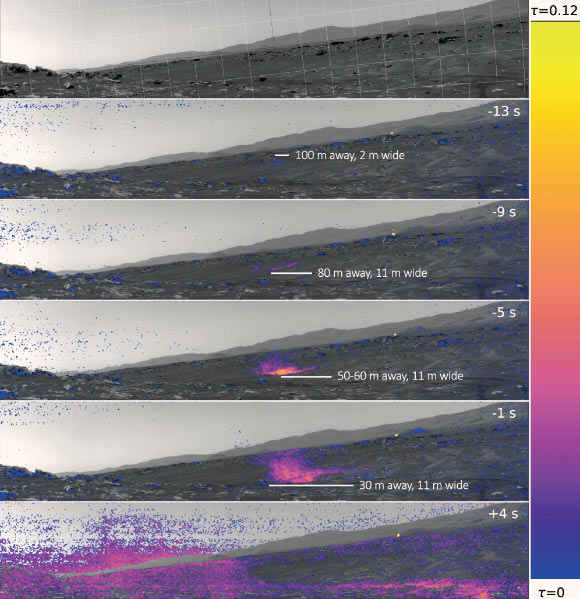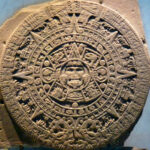Dust devils — convective vortices loaded with dust — are common at the surface of Mars, particularly at Jezero crater, the landing site of NASA’s Perseverance rover. They are indicators of atmospheric turbulence and are an important lifting mechanism for the Martian dust cycle.
Perseverance’s Navigation Camera (Navcam) observations of the direct dust devil encounter: the Navcam scene (the average background image, top panel) and each dust devil image processed to dust amount (five lower panels), masking out only the truly indeterminate areas (gray); the color scale ranges from optical depth, τ = 0 at the bottom (blue) to τ = 0.12 at the top (yellow), and is linear in between; the areas with low signal-to-noise ratio are masked out, and the images also show non-random noise (banding from instrument electronics during readout); the grid on the scene image (top panel) is 5 degrees in local level azimuth and elevation; the darker gray contours are elevation=0 degrees and azimuth=165 degrees. Image credit: Murdoch et al., doi: 10.1038/s41467-022-35100-z.
The sound of a Martian dust devil was recorded on September 27, 2021, by the SuperCam instrument on the Perseverance rover.
The encounter was also simultaneously imaged by the rover’s Navigation Camera and observed by several sensors in its Mars Environmental Dynamics Analyzer instrument.
“We can learn a lot more using sound than we can with some of the other tools,” said Purdue University’s Professor Roger Wiens.
“They take readings at regular intervals. The microphone lets us sample, not quite at the speed of sound, but nearly 100,000 times a second. It helps us get a stronger sense of what Mars is like.”
“The microphone is not on continuously; it records for about three minutes every couple of days. Getting the whirlwind recording was lucky, though not necessarily unexpected.”

Acoustic data during a dusty vortex encounter: (a) the pressure data during the dust devil encounter at 11.02 LTST on September 27, 2021 (Perseverance sol 215); (b) the SuperCam microphone sound amplitude as a function of time; (c) the normalized Root-Mean-Square (RMS) of the microphone signal in the 20-60 Hz bandwidth (the region containing the atmospheric signal) calculated in 2-s windows; (d) the spectrogram of the microphone sound pressure level (calculated using a window size of 0.2 s in order to resolve the fine details in the acoustic data) showing the wind noise, the grain impacts and also the rover pump harmonic at 760 Hz, and the acoustic echo at 6 kHz due to sound reflections from the base of the microphone. Image credit: Murdoch et al., doi: 10.1038/s41467-022-35100-z.
In the Jezero Crater, Professor Wiens and his colleagues have observed evidence of nearly 100 dust devils since the rover’s landing.
“This is the first time the microphone was on when one passed over the rover,” they said.
“The sound recording, taken together with air pressure readings and time-lapse photography, help us understand the Martian atmosphere and weather.”
Combining the unique multi-sensorial data with modeling, they show that the dust devil was around 25 m large, at least 118 m tall, and passed directly over the rover traveling at approximately 5 m per second.
“We could watch the pressure drop, listen to the wind, then have a little bit of silence that is the eye of the tiny storm, and then hear the wind again and watch the pressure rise. It all happened in a few seconds,” Professor Wiens said.
“The wind is fast, but about what you would see in a dust devil on Earth.”
“The difference is that the air pressure on Mars is so much lower that the winds, while just as fast, push with about 1% of the pressure the same speed of wind would have back on Earth.”
“It’s not a powerful wind, but clearly enough to loft particles of grit into the air to make a dust devil.”
The information indicates that future astronauts will not have to worry about gale-force winds blowing down antennas or habitats, but the wind may have some benefits.
The breezes blowing grit off the solar panels of other rovers — especially NASA’s Opportunity and Spirit rovers — may be what helped them last so much longer.
“Those rover teams would see a slow decline in power over a number of days to weeks, then a jump. That was when wind cleared off the solar panels,” Professor Wiens said.
“The lack of such wind and dust devils in the Elysium Planitia where NASA’s InSight mission landed may help explain why that mission is winding down.”
“Just like Earth, there is different weather in different areas on Mars.”
“Using all of our instruments and tools, especially the microphone, helps us get a concrete sense of what it would be like to be on Mars.”
The team’s findings appear today in the journal Nature Communications.
_____
N. Murdoch et al. 2022. The sound of a Martian dust devil. Nat Commun 13, 7505; doi: 10.1038/s41467-022-35100-z




